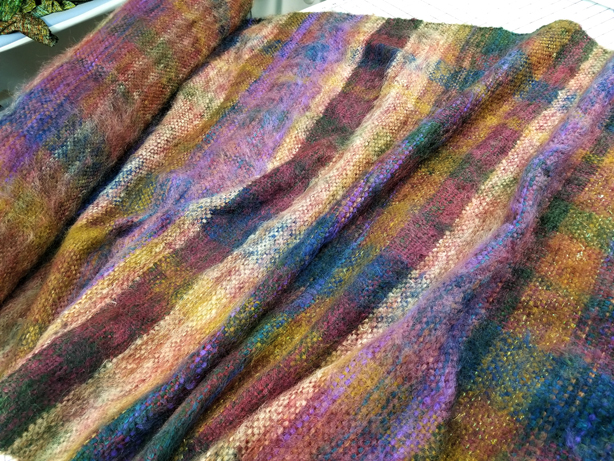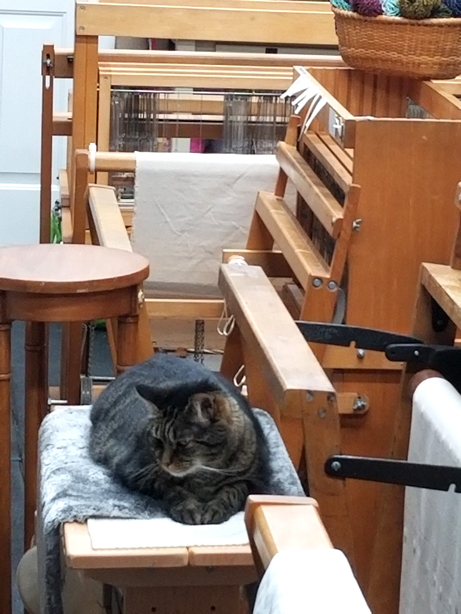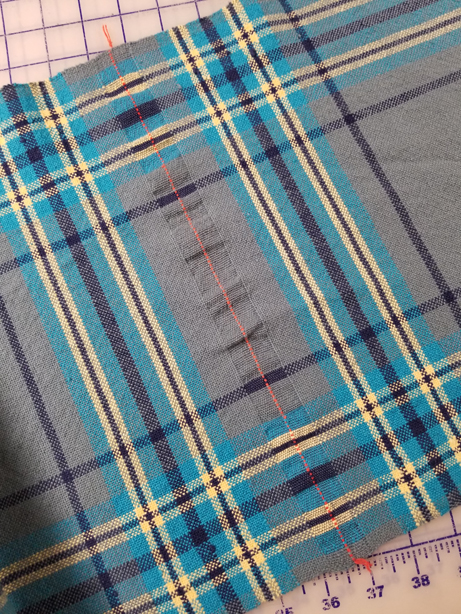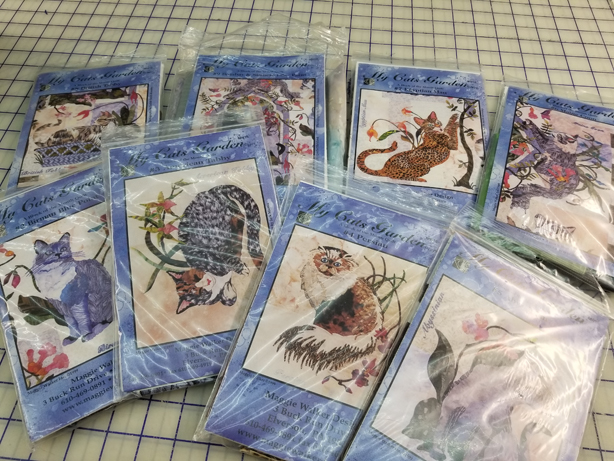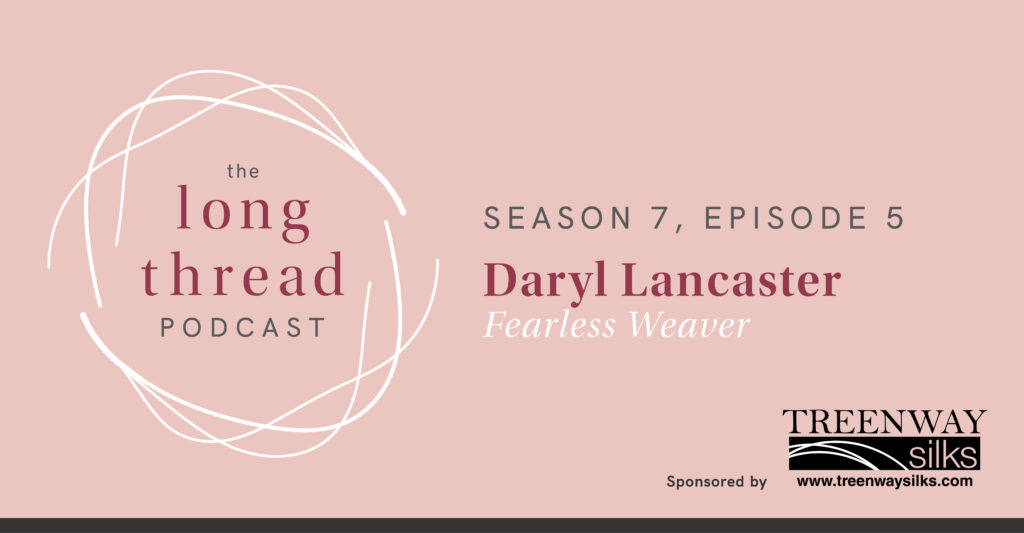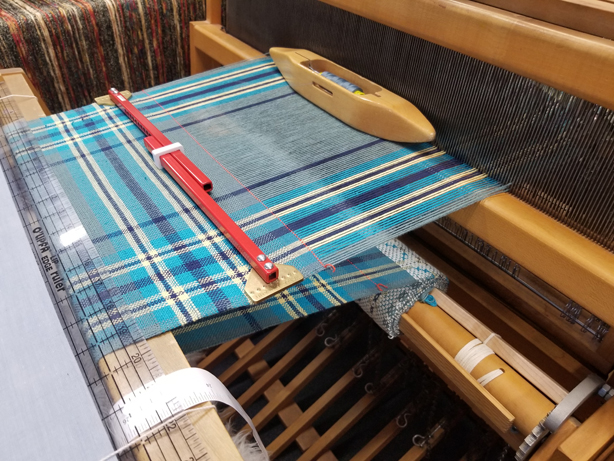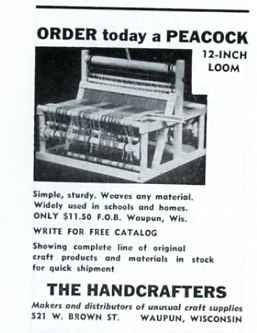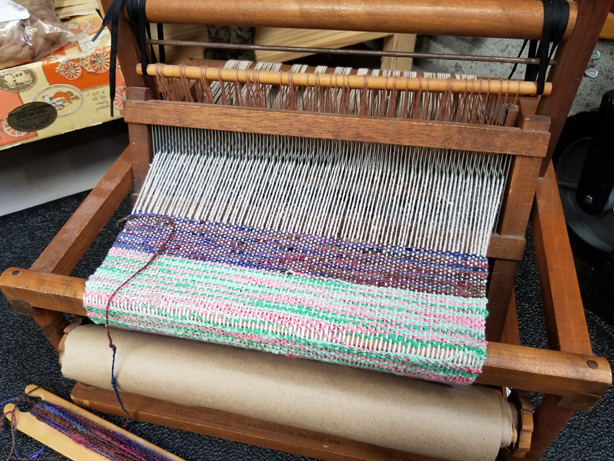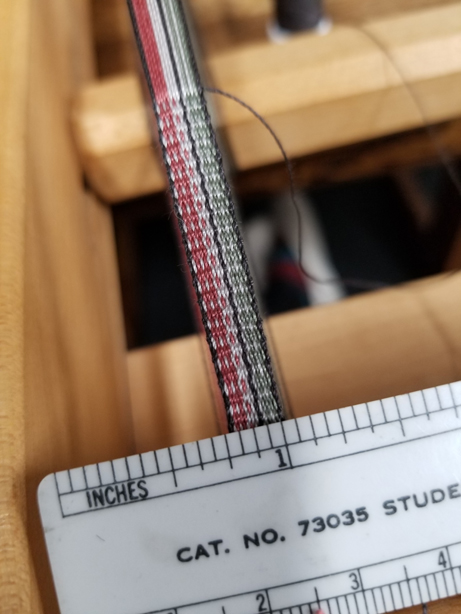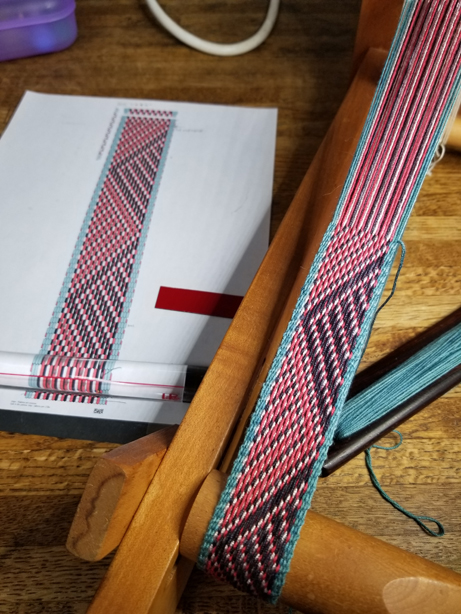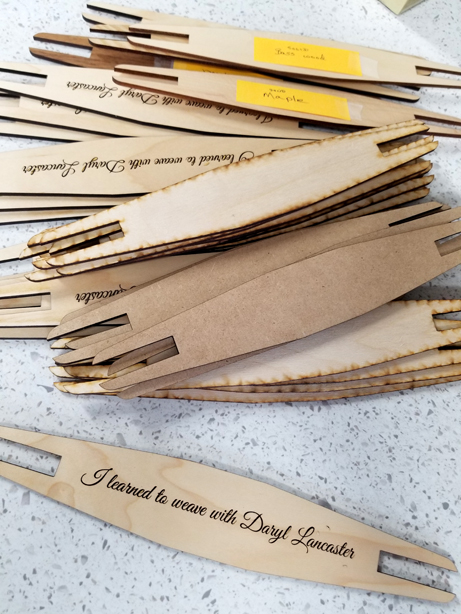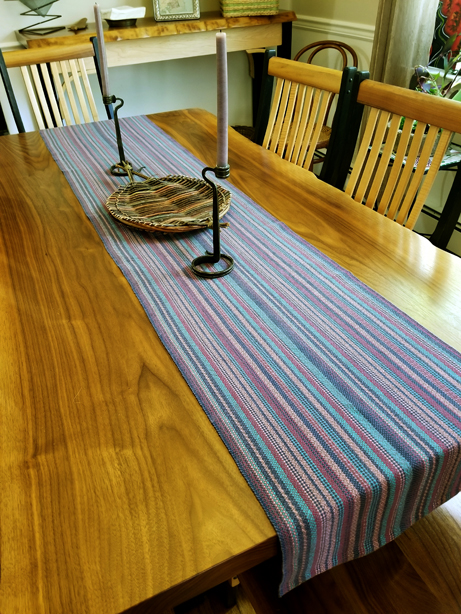This has been a wild week in the studio. First, a little back story…
If you have been following this blog over the past year or so, you know that I set out on a quest to warp all of the 64 looms in the studio, many of them table looms, Structos, or inkle looms. I blogged about them all over a few blog posts.
I’ve set out on a different quest to clear those looms, and rethink my life as to what I want to really hold on to moving forward… The floor looms, at least those that are mine and not my daughter’s, are all cleared. I am a yardage weaver and like nothing better than to sit and weave like a galloping horse. 10 yards, not really a problem. Though I can’t clear off the amount of yardage in one sitting like I could in my 20’s.
So now, I have a bunch of table looms to clear. And if I were really truthful, I hate weaving on a table loom. It is slow and tedious. Especially if there is a complex structure. Like a Bateman Blend, which I set up for a sample for an article I wrote for Heddlecraft Magazine. (Issue #38)

There is nothing like a table loom to explain structure, because you have to hand manipulate each shaft (and in this one there are 8), and though you can achieve a rhythm, it isn’t the same as when your hands and feet are all working together. I found myself bored and distracted. Constantly jumping up to do anything but… At one point I even redid the shaft tie-up system, as this was a used loom, and though I have six others like it, the previous owner did something odd that I thought prevented me from getting the shed I needed. So a trip to the hardware store, and some fine tuning, I was happy with the shed and struggled to get back to weaving.
Meanwhile, at the end of my last post, I talked about this cat appliqué quilt block I inherited from my mom, and I found that I was getting quite obsessed, almost addicted. It was all I wanted to do…

I’d set timers, ok, I’ll work on this section and then weave a few repeats, and then work on the appliqué some more as a treat. It worked for a while since I now have the knots over the back beam, there is only about 6 inches more to weave.

Mostly I would just sit and let my mind wander while I was stitching, and my mind wandered to the calendar. I looked ahead at the next couple months, and there is a lot coming up, private students, some teaching remotely, garden tours and lectures, interesting things, but what made me sit up and stop stitching, was realizing that my guild show and sale is only 2 months away.
Part of my musings are around the amount of equipment and stash that exists in my life. No one is complaining, but there comes a point when is it fair to me to keep holding stuff that is 40 years old? I’m not talking about usable yarn or fabric, I’m talking about scraps in my attic from my 1980 production years. I’ve worked over the last couple of decades to reduce the 18 bankers boxes filled to capacity. But there is still a lot up there. And a lot of it is mohair. Which isn’t so easy to use up in small pieces.
I took a stroll in my attic and started opening drawers, and pulled out one that had some mohair scraps, rather large ones, in a couple color ways, and brought them down to the studio. I got the idea of creating a sweater jacket using the same pattern as my beloved Noro jacket I wove a couple years ago.

I found the pattern and started playing around with what I had on the table. At first, I thought I’d just do a vest, but it was clear I could add a couple of sleeves with some careful piecing.

A couple of small balls of mohair blend in my knitting stash would work well for the crocheted trim around the perimeter of the jacket and the pockets. I’m about half way around.

Which left me with this pile of small scraps.

I reached out to some of my weaving buddies, and asked for ideas for what to do with small scraps of mohair. One of them suggested stuffed animals. I really haven’t made any stuffed animals, I always joke that I don’t do crafts, but the idea was intriguing. I have a data base of all my patterns, including the 20 years of Burda Style Magazine. I quickly found patterns for a squirrel and a rabbit.
There weren’t large enough pieces left in this pile of mohair to do either one, but I had also pulled out some other mohair scraps, thinking I could get a vest or jacket out of those, and they ended up perfect to cut this adorable squirrel. The issue of Burda Style was May 2014.


Meanwhile, I started to think about ornaments I used to make as teacher gifts when my kids were little. I dug out the box I had in my closet, along with an article in Handwoven magazine November/December 2003 (which I wrote, duh…) and thought, wow, some of these like the little bear would be great in mohair.


So I cut out a few bears, and a couple of birds, using a pattern I found along with the box of ornaments.

And I started playing around with a stocking. I didn’t like the first iteration, the one on the right, and my daughter helped me refine the pattern to the one on the left. I thought the body of the stocking was just a little to high, so I’ve cut out probably a half dozen just a little bit shorter.
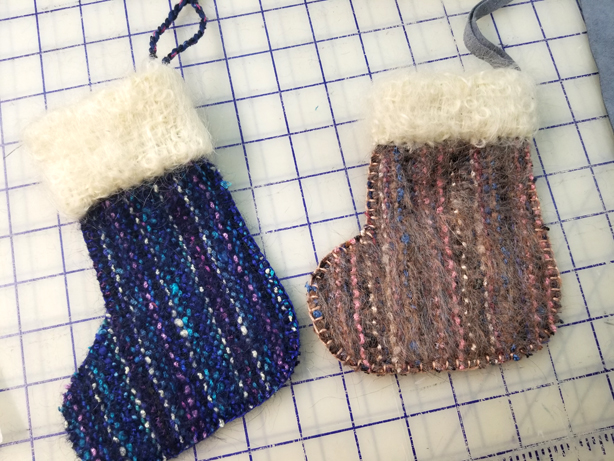
Meanwhile, I grabbed some non mohair scraps, including a bag labeled, scraps for coiled mats. Most of the work was already done. I made a coiled mat out of one of the piles.

And then made a second one, using up a ball of filler cord. I have a huge spool in the attic, so there is plenty more mats in my future.
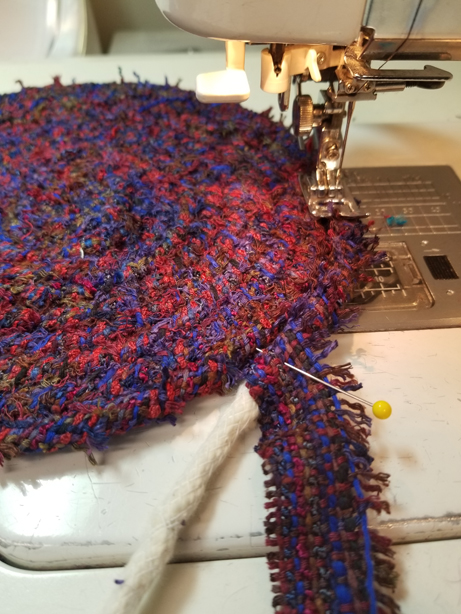

Meanwhile, I pulled this bag of non mohair scraps, it is a color way I always loved, and there wasn’t a lot left. One of my private students told me about a base fabric she uses for bags and totes, she is from the quilting world, called In-R-Form foam from Bosal. She actually sent me a few yards to play with. It is a foam with great stability, yet more flexibility than the Peltex I have been using. So, much easier to work on. I laid out a tote.

And finished it off yesterday morning.
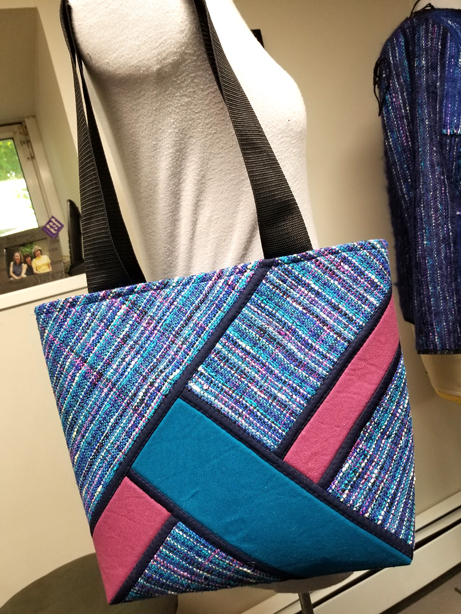
Meanwhile, I took the scraps left from the tote, and cut more ornaments. I can’t tell you what a mess I made of my studio, pulling ribbons and floss and Ultrasuede scraps and most important, buttons. The cat parked himself right in the middle of it all to supervise.
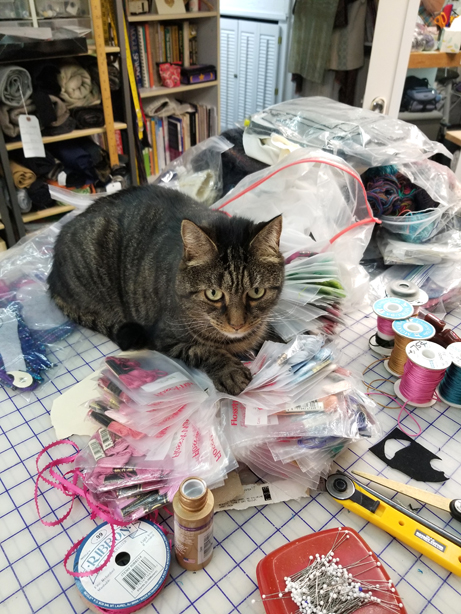
So here are a bunch of ducks… All in a row!

And I have little project bags for each of the couple dozen ornaments I’ve cut out. I can grab one and start assembling.

And yesterday afternoon, I made a rabbit from another colorway of mohair I had up in the attic. This one is from a Burda Style Magazine April 2014. I’m completely in love with this rabbit, and would love to keep him, but I’d have to keep him in the closet because my dog likes things with stuffing. It would be destroyed in 10 minutes. And I would be heartbroken. So it will find someone else to live with at my guild sale in November. It needs a ribbon around its neck, perhaps an inkle band, and I might redo the mouth with a full six strands of floss.

I haven’t been this intense in the studio in years. I just want to be down there, working until midnight, forgetting to eat, pissed when I have an appointment to interrupt me. It feels like falling in love all over again. That Bateman Structure on the loom, I still have about 6″ to go, and I still have to finish the last 3 letters of the name of the cat in the quilt block. (And there are 8 more cat quilt blocks in the set). They will get done, but I’m just having way too much fun thinking of things to make with this bonanza of leftovers from the 1980’s.
There is a monograph showing all of the techniques I used, available on my website as a download. And I have 3 or 4 videos on my YouTube channel, The Weaver Sews, on the piecing technique I used for the tote bag. They were some of the last ones we shot.
My favorite month since I was a little kid was September. The change in weather, fresh pencils and notebooks, the chance to learn new things; September is always a shot in the arm for me. I’d say I dove in to this month head first…
Stay tuned…







